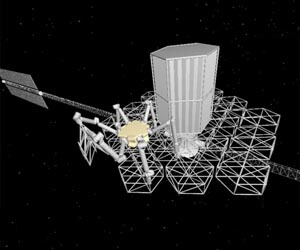Improving astronomers' ability to peer deeper and deeper into the universe depends on the development of large space telescopes. A new concept in space telescope design uses a modular structure that is assembled in space by a robot. In this way it is possible to build a very large telescope in space, a task that human astronauts would have difficulty with

Improving astronomers' ability to peer deeper and deeper into the universe depends on the development of large space telescopes. A new concept in space telescope design uses a modular structure that is assembled in space by a robot. In this way it is possible to build a very large telescope in space, a task that human astronauts would have difficulty with.
The robotically assembled modular space telescope (RAMST) design, developed by Nicholas Lee and his colleagues at the California Institute of Technology and NASA's Jet Propulsion Laboratory, and published by the International Society for Optics and Photonics SPIE in the journal: Astronomical Telescopes, Instruments and Systems (JATIS )..
Ground telescopes are limited by atmospheric effects and can only view part of the sky, depending on their location on Earth. Space telescopes do not have these disadvantages but have other limitations such as total launch volume and weight.
The modular space telescope will be able to overcome limitations of volume and weight by allowing the telescope's components to be launched gradually, which enables the design and deployment of very large space telescopes.
The design detailed by Lee and his colleagues in the article "Architecture in Space - Robotic Assembly of a Modular Space Telescope," focuses mainly on a robotic system that will perform tasks where astronaut fatigue will be a problem.
"Our goal is to answer the main technical challenges of this architecture, so that future concept studies can answer a specific scientific motivation for building such a telescope." the researchers write.
The main features of the architecture proposed by the authors include a mirror built with a modular structure, a robot that will assemble the telescope and provide continuous services, as well as advanced metallurgical technologies to support the assembly and operation of the telescope.
"Another important capability is the potential to launch disassembled components into a telescope and open them up in space," says Harley Tornson, Senior Scientist for Astrophysical Systems at NASA's Goddard Space Center.
For example, astronomers using ground-based telescopes are used to them functioning for decades, and the Hubble Space Telescope has shown us that this is also possible in space given the availability of astronauts. A robotic system for assembly, upgrading, repairs and delivery will enable a long useful life for space telescopes of all types.

3 תגובות
The title is misleading. It sounds as if there is such a project and they are going to build such a telescope in space, while the article in question offers preliminary planning at the concept level and architecture. Not about a real robot, and not about a future mission.
The telescope may be able to survive for decades, but who will repair the robot?
This is a complex device, which is likely to perform repairs partially autonomously even with a delay of a few seconds of contact with it. Unless we send some smaller robots with it, to repair it, it too can break down to the same extent. Plus, it also has a lot more moving parts than a telescope to break
It is absolutely necessary to mention this little gem:
https://www.scribd.com/doc/114272440/Insert-Knob-A-in-Hole-B-by-Isaac-Asimov